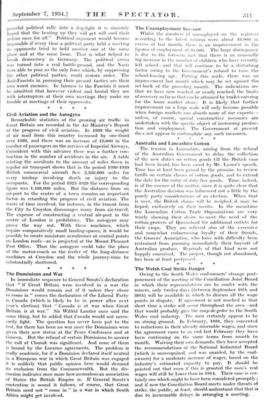Civil Aviation and the Autogyro Remarkable statistics of the growing
air traffic in Great Britain are recorded in the Air Ministry's Report of the progress of civil aviation. In 1933 the weight of air mail from this country increased by one-third over 1932, and there was an increase of 19,000 in the number of passengers on the services of Imperial Airways. Coincident with this advance there was a further con- traction in the number of accidents in the air. A table relating the accidents to the amount of miles flown in regular air transport shows that in the period 1930-1933 British commercial aircraft flew 2,336,000 miles for every mishap involving death or injury to the occupants. For the period 1925-1929 the corresponding figure was 1,493,000 miles. But the distance from an air-port to the centre of a town remains an important factor in retarding the progress of civil aviation. The waste of time involved, for instance, in the transit from the City to Croydon discourages many from air-travel. The expense of constructing a central air-port in the centre of London is prohibitive. The autogyro may prove the way out. With these machines, which require comparatively small landing-spaces, it would be possible to create miniature aerodromes at central points on London roofs—as is projected at the Mount Pleasant Post Office. Thus the autogyro could take the place of the motor-coach as the feeder of the long-distance machines at Croydon and the whole journey-time be substantially shortened.






































 Previous page
Previous page